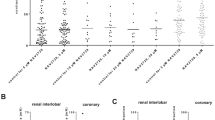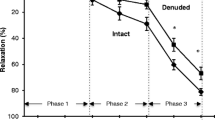Summary
Smooth muscle relaxant activity of endothelium-derived relaxing factor (EDRF) released from columns of cultured bovine endothelial cells by bradykinin (0>1 — 3 nmol/l) was measured in four non-vascular preparations: guinea-pig taenia caeci, guinea-pig trachea, rat stomach (fundus) and rat anococcygeus. Each preparation was contracted to a steady level of force with a variety of agonists such that they relaxed optimally to sodium nitroprusside (SNP). The EDRF-induced relaxations in each preparation were compared with those obtained in de-endothelialized ring preparations of greyhound coronary artery by means of paired bioassays run in parallel. EDRF released from the endothelial cell columns caused 80–100% relaxation of the coronary artery, 40–80% in the guinea-pig taenia caeci, 50–70% in the rat anococcygeus, 5–8% in the guinea-pig trachea and was undetectable in the rat stomach strip. By comparison, SNP caused maximal relaxation in all tissues compared with the coronary artery.
In separate organ bath experiments the sensitivity to nitric oxide (NO: generated by adding acidified solutions of NaNO2) and SNP was compared in each preparation. SNP caused maximal relaxation in all tissues with the following order of potency: dog coronary artery > guinea-pig trachea > guinea-pig taenia = rat anococcygeus > rat stomach strip. In contrast, the concentration of acidified NaNO2 (NO, 300 nmol/l) that caused 96 ± 4% relaxation in the dog coronary artery caused 84 ± 7% and 48 ± 1 % relaxation in the taenia and anococcygeus respectively. No response attributable to NO was detected in either the trachea or rat stomach strip.
In conclusion, EDRF relaxed both vascular and certain non-vascular smooth muscles with the same order of potency and magnitude as NO generated from acidified solutions of NaNO2. This correlation provides further evidence that NO and EDRF are similar, if not identical.
Similar content being viewed by others
References
Angus JA, Cocks TM (1987) The half-life of endothelium-derived relaxing factor released from bovine aortic endothelial cells in culture. J Physiol 388:71–81
Angus JA, Cocks TM (1989) Endothelium-derived relaxing factor. Pharmacol Ther 41:303–351
Buga GM, Gold ME, Wood KS, Chaudhuri G, Ignarro LJ (1989) Endothelium derived nitric oxide relaxes non-vascular smooth muscle. Eur J Pharmacol 161:61–72
Cocks TM, Angus JA (1983) Endothelium-dependent relaxation of coronary arteries by noradrenaline and serotonin. Nature 305:627–630
Cocks TM, Angus JA, Campbell JH, Campbell GR (1985) Release and properties of endothelium-derived relaxing factor (EDRF) from endothelial cells in culture. J Cell Physiol 123:310–320
Cocks TM, Angus JA, Grego B (1987) Properties of endotheliumderived relaxing factor (EDRF) released from cultured endothelial cells. Proceedings of the Xth International Congress on Pharmacology, Sydney. Elsevier, Amsterdam
Dusting GJ, Macdonald PS, Read MA, Stewart AG (1988) Endothelium-derived relaxing factor released from cultured cells: differentiation from nitric oxide. Clin Exp Pharmacol Physiol 15:83–92
Ferrero JD, Cocks TM, Burnstock G (1980) A comparison between ATP and bradykinin as possible mediators of the responses of smootn muscle to non-aorenergic, non-cnounergic nerves. Eur J Pharmacol 63:295–302
Furchgott RF (1984) The role of endothelium in the responses of vascular smooth muscle to drugs. Annu Rev Pharmacol Toxicol 24:175–197
Gillespie JS (1972) The rat anococcygeus muscle and its response to nerve stimulation and to some drugs. Br J Pharmacol 45:404–416
Gillespie JS, Sheng H (1988) Influence of haemoglobin and erythrocytes on the effects of EDRF, a smooth muscle inhibitory factor, and nitric oxide on vascular and non-vascular smooth muscle. Br J Pharmacol 95:1151–1156
Gruetter CA, Gruetter DY, Lyon JE, Kadowitz PJ, Ignarro LJ (1981) Relationship between cyclic guanosine 3′,5′-monophosphate formation and relaxation of coronary arterial smooth muscle by glyceryl trinitrate, nitroprusside, nitrite and nitric oxide: effects of methylene blue and methemoglobin. J Pharmacol Exp Ther 219:181–186
Ignarro LJ, Kadowitz PJ (1985) The pharmacological and physiological role of cyclic GMP in vascular smooth muscle relaxation. Annu Rev Pharmacol Toxicol 25:171–191
Ignarro LJ, Byrns RE, Buga GM, Wood KS (1987) Endotheliumderived relaxing factor from pulmonary artery and vein possesses pharmacologic and chemical properties identical to those of nitric oxide radical. Circ Res 61:866–879
Ignarro LJ, Buga GM, Chaudhuri G (1988) EDRF generation and release from perfused bovine pulmonary artery and vein. Fur J Pharmacol 149:79–88
Katsuki S, Murad F (1977) Regulation of adenosine cyclic 3′,5′-monophosphate and guanosine cyclic, 3′,5′-monophosphate levels and contractility in bovine tracheal smooth muscle. Mol Pharmacol 13:330–341
Kelm M, Schrader J (1988) Nitric oxide release from the isolated guinea pig heart. Eur J Pharmacol 155:317–321
Long CJ, Berkowitz BA (1989) What is the relationship between the endothelium-derived relaxant factor and nitric oxide? Life Sci 45:1–14
Marshall JJ, Wei EP, Kontos HA (1988) Independent blockade of cerebral vasodilation from acetylcholine and nitric oxide. Am J Physiol 255:H847-H854
Martin W, Villani GM, Jothianandan D, Furchgott RF (1985a) Selective blockade of endothelium-dependent and glyceryl trinitrate-induced relaxation by hemoglobin and by methylene blue in the rabbit aorta. J Pharmacol Exp Ther 232:708–716
Martin W, Villani GM, Jothianandan D, Furchgott RF (1985b) Blockade of endothelium-dependent and glyceryl trinitrate-induced relaxation of rabbit aorta by certain ferrous hemoproteins. J Pharmacol Exp Ther 233:679–685
Moncada S, Palmer RMJ, Higgs EA (1987) Prostacyclin and endothelium-derived relaxing factor: biological interactions and significance. In: Verstraete M, Vermylen J, Lijnen HR, Arnout J (eds) Thrombosis and haemostasis. Leuven University Press, Leuven, pp 597–618
Moncada S, Palmer RMJ, Higgs EA (1988) Biosynthesis of nitric oxide from L-arginine. A pathway for the regulation of cell function and communication. Biochem Pharmacol 38:1709–1715
Mülsch A, Böhme E, Busse R (1987) Stimulation of soluble guanylate cyclase by endothelium-derived relaxing factor from cultured endothelial cells. Eur J Pharmacol 135:247–250
Mülsch A, Busse R, Liebau S, Förstermann U (1988) LY83583 interferes with the release of endothelium-derived relaxing factor and inhibits soluble guanylate cyclase. J Pharmacol Exp Ther 247:283–288
Myers PR, Guerra R Jr, Harrison DG (1989) Release of NO and EDRF from cultured bovine aortic endothelial cells. Am J Physiol 256:H1030-H1037
Palmer RMJ, Ferrige AG, Moncada S (1987) Nitric oxide release accounts for the biological activity of endothelium-derived relaxing factor. Nature 327:524–526
Rapoport RM, Murad F (1983) Agonist-induced endothelium-dependent relaxation in rat thoracic aorta may be mediated through cGMP. Circ Res 52:352–357
Shikano K, Berkowitz BA (1987) Endothelium-derived relaxing factor is a selective relaxant of vascular smooth muscle. J Pharmacol Exp Ther 243:55–60
Shikano K, Ohlstein EH, Berkowitz BA (1987) Differential selectivity of endothelium-derived relaxing factor and nitric oxide in smooth muscle. Br J Pharmacol 92:483–485
Shikano K, Long CJ, Ohlstein EH, Berkowitz BA (1988) Comparative pharmacology of endothelium-derived relaxing factor and nitric oxide. J Pharmacol Exp Ther 247:873–881
Vane JR (1957) A sensitive method for the assay of 5-hydroxytryptamine. Br J Pharmacol 12:344–349
Waldman SA, Murad F (1987) Cyclic GMP synthesis and function. Pharmacol Rev 39:163–196
Author information
Authors and Affiliations
Additional information
Send offprint requests to T. M. Cocks at the above address
Rights and permissions
About this article
Cite this article
Cocks, T.M., Angus, J.A. Comparison of relaxation responses of vascular and non-vascular smooth muscle to endothelium-derived relaxing factor (EDRF), acidified sodium nitrite (NO) and sodium nitroprusside. Naunyn-Schmiedeberg's Arch Pharmacol 341, 364–372 (1990). https://doi.org/10.1007/BF00180663
Received:
Accepted:
Issue Date:
DOI: https://doi.org/10.1007/BF00180663




